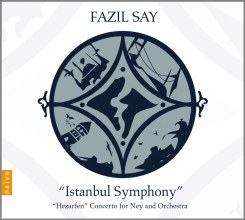Istanbul Symphony
‘Hezarfen’ Concerto for Ney and Orchestra
This live recording of two major works by Turkish composer and pianist Fazil Say is a recent release on the Naive label. Comprising two disks – a CD plus DVD footage of the Symphony and documentaries about both works – there is much to discover here. And, taking the CD as a starting point for Fazil Say’s work, what a voyage of discovery it turned out to be!
The Istanbul Symphony was Fay’s first, written in 2009 and premiered in 2010, with this live recording by the Borusan Istanbul Symphony Orchestra under the baton of Gürer Aykal following later that year. The Concerto is even more recent, composed in 2011 and recorded live at the world premiere performance by Burcu Karadağ with The Orchestra of Nationaltheater Mannheim under Dan Ettinger in March 2012.
The Symphony is in seven movements, providing a flavour of Istanbul past and present, (or one seen through the eyes of the other). The soundworld combines elements of Turkish music and Western classical music, with some unfamiliar instruments in the mix, including the ney (reed flute), kanun (traditional zither) and a range of percussion instruments with onomatopoeic names like kudüm, bendir and darbuka. There is powerful playing throughout, with great spirit, tight rhythmic precision and a wonderful ensemble sound.
The first movement takes us on a journey back in time to the Istanbul of the past, with Turkish tonality and shades of Sibelius. Starting with the sound of waves, the music builds to powerful full orchestra and thumping drums, before gradually calming with repetitive light percussion and ending with a melancholy solo ney. The next movement suggests a religious ritual, built around repeating rhythms, hypnotic and growing in intensity. There’s a dance-like section reminiscent of a Stravinsky ballet score, and persistent percussion with huge chordal interjections.
This is followed by a slow, meditative third movement depicting the iconic Blue Mosque, stately and dignified. Modal Turkish music contrasts with a lush viola theme, like beautiful, poignant film music, and the breathy flute sounds of the expressive ney have an almost vocal quality. What a find! The next movement features the flute in a simple, joyful melody with the orchestra in romantic mood, conjuring up a carefree time of enjoyment and relaxation on an island getaway.
Movement five takes us on a train journey to far destinations, the train’s movement relentless in its rhythm. An improvised kanün solo leads us into the penultimate movement, with its exciting, spirited dance tunes evoking a night out. The final movement sees the return of nostalgic reminiscence, as the ney’s semitone falls sound like a melancholy call back to another time. Finally the music returns to the sea, from which it came. An effective, evocative and powerful work.
The Concerto for Ney and Orchestra is inspired by the legendary Ottoman aviation pioneer Hezarfen Ahmet Çelebi, who made the first human flight in 1632, travelling a distance of about four kilometres. The title is revealing, as the ney and orchestra are equal partners as joint soloists in this work, albeit with different roles. In four movements, the concerto tells the story of that first successful flight and its unsuccessful consequences.
The first movement sets the scene, its low Ney theme suggesting a muezzin call at start of day, with a major / minor tonality and feeling of mounting anticipation. The second depicts the crowd gathering to watch the momentous event, with a dramatic repeating figure in the orchestra and the ney singing above. Tension mounts as one individual’s taunts are conveyed by a rhythmic motif, and the movement concludes with the solo ney, full of eloquence.
The third movement depicts the flight itself, and is similar in length to that first foray into the sky. The music is eerie and atmospheric, initially full of uncertainty and trepidation, but later more confident. These sounds are alien and other worldly, as indeed the whole concept of human flight would have been at that time. An assortment of unconventional instruments add to the odd soundscape, with the airy voice of the Ney representing the spirit of the pilot and the feel of flight.
The final movement sees Hezarfen’s comedown, seen as a threat and exiled in punishment for his achievement. Low instruments and a relentless drum suggest punishment, building to a climax. The aviator’s spirit remains a clear communicator as the solo ney’s expressive melody refers back to the flight, as if to say “I have flown”. There is sadness that his achievement results in being ostracised, and the work is brought to a close with a drum thump full stop.
Coming fresh to this composer’s work, I was extremely impressed and am looking forward to discovering more about his works. First on the list will be the DVD…
Alison Owen-Morley: February 2013


Pingback: A voyage of discovery | studioflamingo